Welcome
to the website of Stanislaw Lewkowicz
Stanislaw Lewkowicz is a Dutch-born, Amsterdam-based, international visual artist. His art is seen in public space and is included in museum, corporate and private collections. Stanislaw Lewkowicz has received multiple awards for his innovative lithographic work. In addition, some of his artworks are included in the list of 100 most important works of art in the public space of the Netherlands.
He also received several grants from the Mondriaan Fund (Netherlands) and was ‘Artist in Residence’ in Calcutta, India.
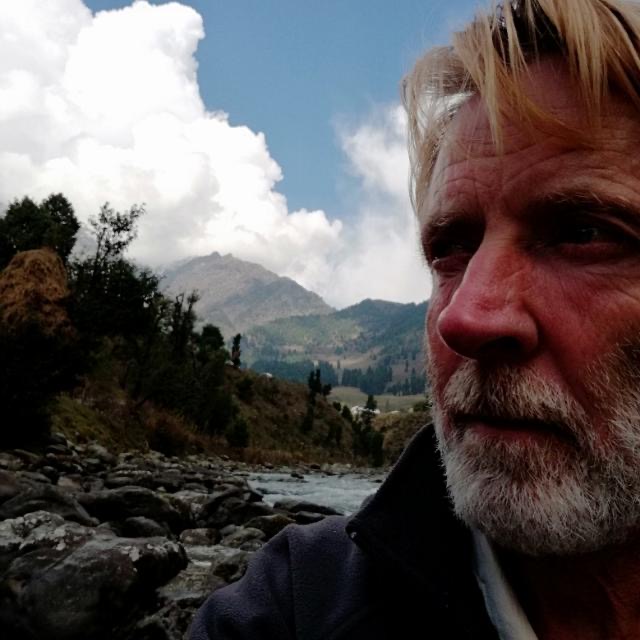
Stanislaw Lewkowicz Kashmir
Artist statement
For many, being an artist is a profession, a profession that can be practiced after several years of academic study in which not only the craft part is learned but also the mind is formed. Stanislaw Lewkowicz believes that being an artist is not a profession but a calling, that only the craft part can be learned and that this does not necessarily require academic study. According to him, an artist’s mind is formed by the artist himself. That is precisely what makes an artist distinctive. Many will agree with him, but may still find it a romantic view.
His place within Dutch art tradition
Placed within Dutch art tradition, his work breathes the spirit of the ‘Tachtigers’, but with the difference of more than a century of art development in between. The ‘Tachtigers’ (from 1880s onwards) were a group of writers, poets and painters who pleaded for art as 'the most individual expression of the most individual emotion' (Willem Kloos, Dutch poet, 1859-1938). Personal experiences and sensory impressions were important. At the same time, they wanted to place these experiences and impressions in a metaphysical context, beyond the individual level. The moralization of art or the use or deployment of art for a specific purpose or to underline a specific goal was rejected.
They found their inspiration in their immediate surroundings and on the streets. In addition to the sketches they made during their walks, they also took snapshot-like photos. Back in their studios, they used these together with their sketches as a base for their artwork. This makes the ‘Tachtigers’ among the first artists to integrate photography into artwork in such a direct way.
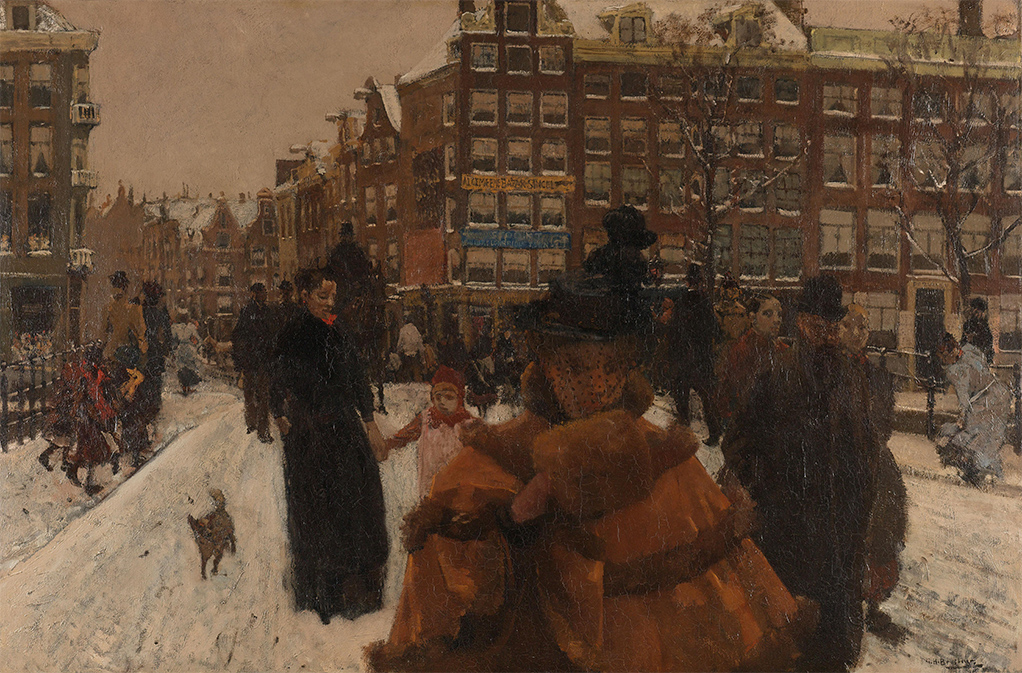 **George Hendrik Breitner, SINGEL BRIDGE, oil on canvas, 100 x 152 cm, Amsterdam, 1896-1898, collection Rijksmuseum, Amsterdam
**George Hendrik Breitner, SINGEL BRIDGE, oil on canvas, 100 x 152 cm, Amsterdam, 1896-1898, collection Rijksmuseum, Amsterdam
Sensory art
Stanislaw Lewkowicz works in the same way. He also works from personal experiences and sensory impressions. His work is also ‘sensory art’. In the manner of a contemporary vlogger he uses snapshots and sketches from everyday life. As a participant in it. And at the same time on the sideline as an observer, as a chronicler of everyday life. As a vlogger of ‘being’. This seemingly contradictory, but essentially non-dualistic attitude places his work in a metaphysical context that transcends the individual level.
Text is a regularly recurring element in his work. Short sentences reminiscent of the Japanese haiku. Thoughts and observations expressed in short, non-rhyming verses are reminiscent of the Indian mystic poet Kabir (1398-1518) and the Persian poet-philosopher Jalal ad-Din Rumi (1207-1273). The sensitivity and melancholy in the work of the Bengali writer and poet Rabindranath Tagore (1861-1941) are also tangible. Recently, text fragments from newspaper articles have been introduced. Newspaper articles about dramatic events that could happen to any of us, newspaper articles about the state of the world and the human spirit.
A link with the work of the Austrian painter Gustav Klimt (1862-1918) is becoming increasingly visible in the use of materials such as gold, rhinestones and all kinds of waste as relics of our society. A use of materials rarely seen in Dutch art. Also he does not shy away from integrating the work of local craftsmen into his artwork.
Lithography
As his main medium Stanislaw Lewkowicz uses lithography to realize most of his artworks.
Lithography, also known as stone printing, is a graphic technique. But in addition to its graphic qualities, lithography also has distinct drawing and painting qualities. These drawing and painting qualities clearly distinguish lithography from all other graphic techniques, such as etching, screen print, woodcut, etc.
Lithography is basically a simple technique and is nothing more than making a drawing, painting or watercolor on a stone with a black, greasy pencil or marker, or with black, greasy ink.
With a litho press, this is transferred from the stone to paper or another material. Depending on the preparation of the drawing, painting or watercolor on the stone, one or more prints can be made, either in a color or in black. For each color a separate drawing, painting or watercolor is required. By printing these on top of each other, an image gradually emerges. This procedure is similar to painting with oil paint or watercolor in layers.
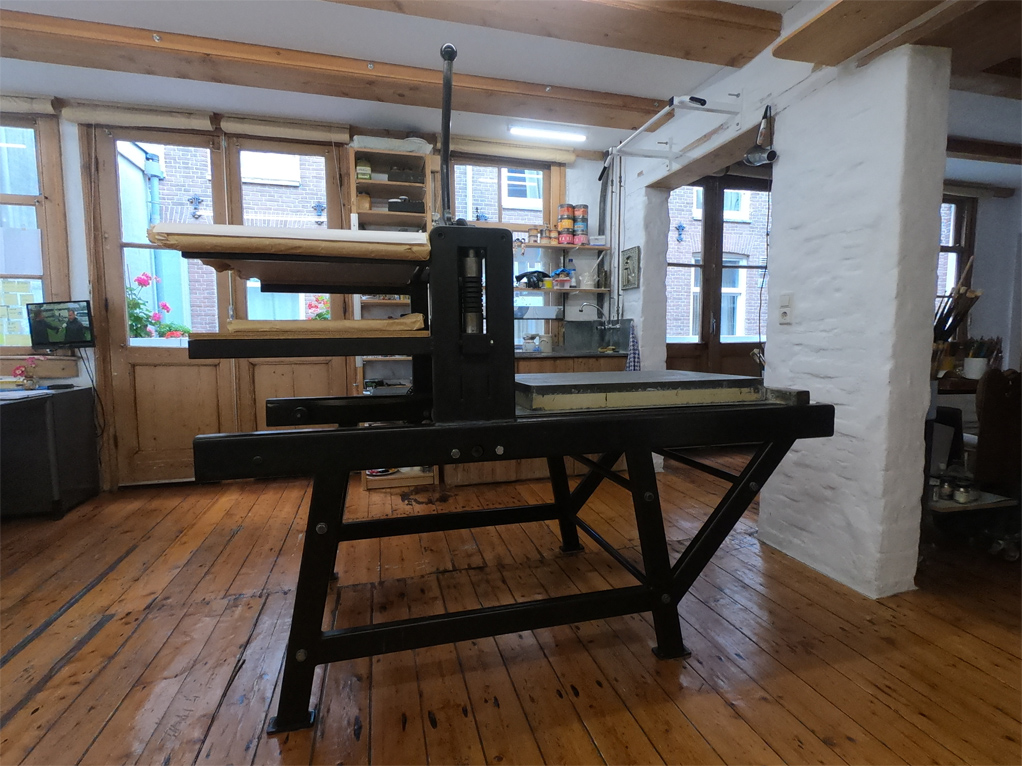
**litho press with stone
Lithography originated in the 19th century. This technique was originally used to produce advertising material in larger numbers. Although lithography has long been out of use in the advertising industry and printing identical images in larger quantities has become less important, yet the lithographic technique is still taught and practiced in the traditional way as if time has stood still and nothing has changed in the purpose of lithography.
According to Stanislaw Lewkowicz, this clinging to redundant methods and outdated insights into lithography has a frustrating effect on artists who want to use lithography as a medium. Particularly in the Netherlands this has led to the fact that working on stone is experienced as too difficult and too cumbersome. As a result lithography is hardly practiced anymore. Real knowledge about what lithography entails and knowledge about the essence of lithography has almost disappeared in the Netherlands. Due to this lack of knowledge, lithographic work is often no longer even recognized as lithography.
Instead of just a technique, a craft, lithography seems to be part of Stanislaw Lewkowicz's very being. His way of performing the lithographic technique makes the seemingly impossible, possible in lithography. In addition, other media such as photography, offset and assemblage are fully integrated into his lithography. Over time, his lithography has increasingly taken on a hybrid form, which can make it difficult to recognize his work as lithographic or to place it within a specific art form.
This unorthodox and inimitable way of practicing lithography earned him the title 'Prince of Lithography'. This approach, however, is not appreciated by all graphic artists, printmakers and collectors. The graphic world is generally a world in which more value is placed on a more traditional approach and a stricter execution of the craft.
Foreigner and one-hit wonder
Probably because of his foreign name, Stanislaw Lewkowicz, born and raised in the Netherlands, is described by some as that 'Pole' who, because of his origins, will never be able to understand anything of Dutch art. Apart from the fact that this is incorrect, one can ask why contemporary art should have a national orientation. Impressive and striking works of art by him in prominent locations, such as an airport, a highway or an embassy, are referred to as minor works of art in minor locations. His artwork is regularly described as too beautiful, as coincidental and consequently superficial and insignificant. Despite this, some of his works of art have been included in the list of most important works of art in public space in the Netherlands and he has received several awards for his work. That is why it is all the more surprising why ever since his first steps in the art world, he still often is labeled as a one-hit wonder. All the more so because his work has rarely been described with attention and has rarely been interpreted. As with many works of art, his artwork is not meant for quick consumption. Comparable to the time and effort that must be taken to read and understand a book or a poem, or the time it takes to experience music and singing, one will have to take time and effort to undergo his work.
A cross section of his art
The artwork of Stanislaw Lewkowicz shows not only stand-alone work, but also a lot of work in series.
His graduation work 'L'Enfant et les Sortilèges' (based on the opera 'L'Enfant et les Sortilèges' composed between 1919 and 1925 by Maurice Ravel, 1875-1937) is his first extensive serial artwork. In this series, the unique painting and drawing qualities of lithography are already fully expressed in Stanislaw Lewkowicz's drawing style and his exuberant use of colour. In this first series his experimental approach already breaks through all the conventions and taboos that are so persistently imposed on lithography to this day.
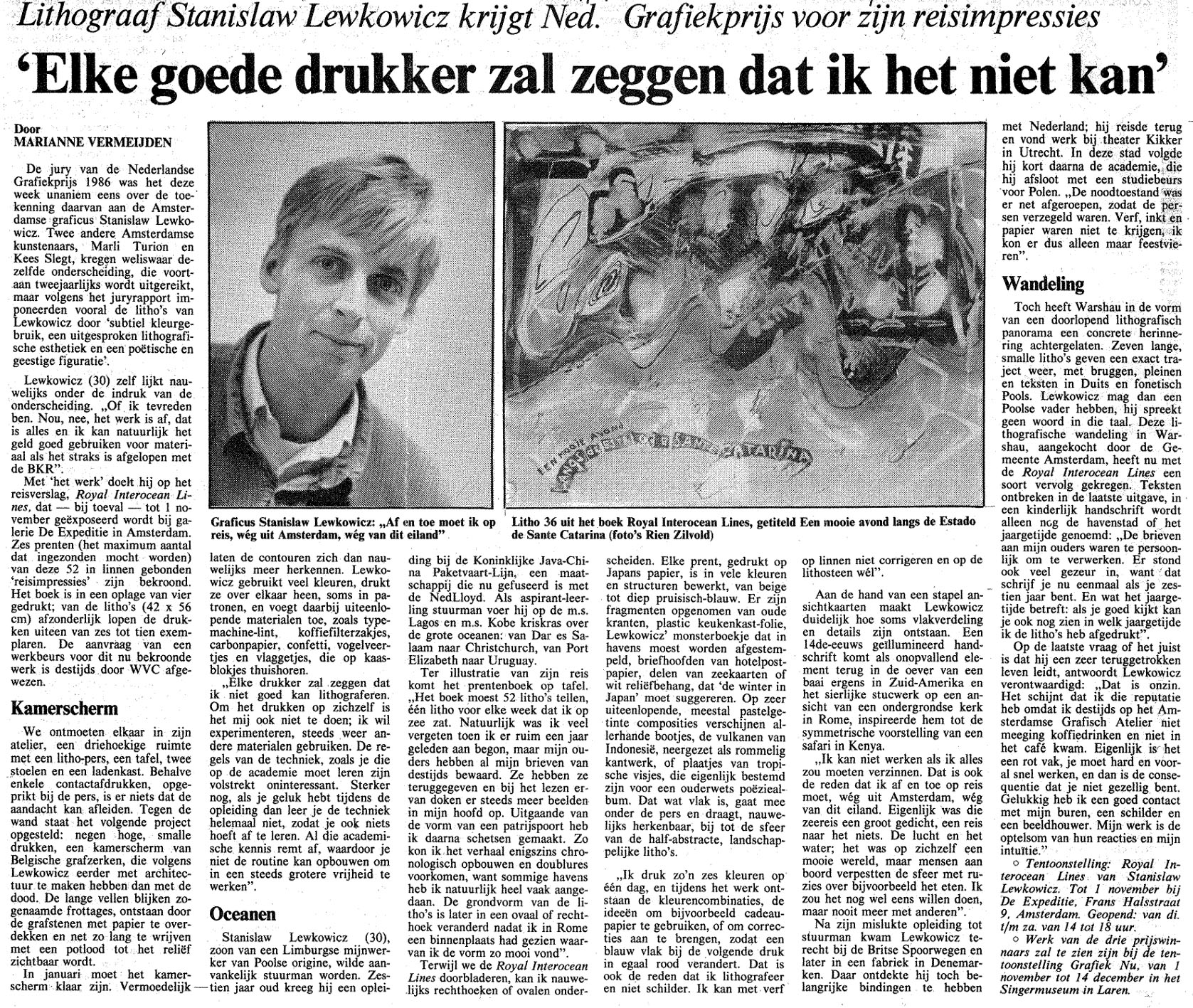
ROYAL INTEROCEAN LINES, NRC Handelsblad, October 11, 1986
Many more series followed, such as ‘Warsaw Review’ or the hallucinatory and multi-award-winning series ‘Royal Interocean Lines’. This series instantly earned him national fame. It is an extensive experimental visual report of a journey of a boy discovering the world by criss-crossing the oceans on a merchant ship. A world that until then was not much bigger than a residential area somewhere in a remote corner of the Netherlands.
Another important series is 'O Muorto o stuorto accucchiame sempe', a series of works in the footsteps of the Grand Tour. From the 17th to the early 19th century, the Grand Tour was a popular journey through Central Europe, the Mediterranean and the Middle East with the aim of gaining knowledge and exploring classical antiquity. 'O Muorto o stuorto accucchiame sempe’ is executed as a 28-part, partly three-dimensional and almost cinematic installation of lithography on transparent material, incorporated in glass, polyveneer and corrugated sheet.
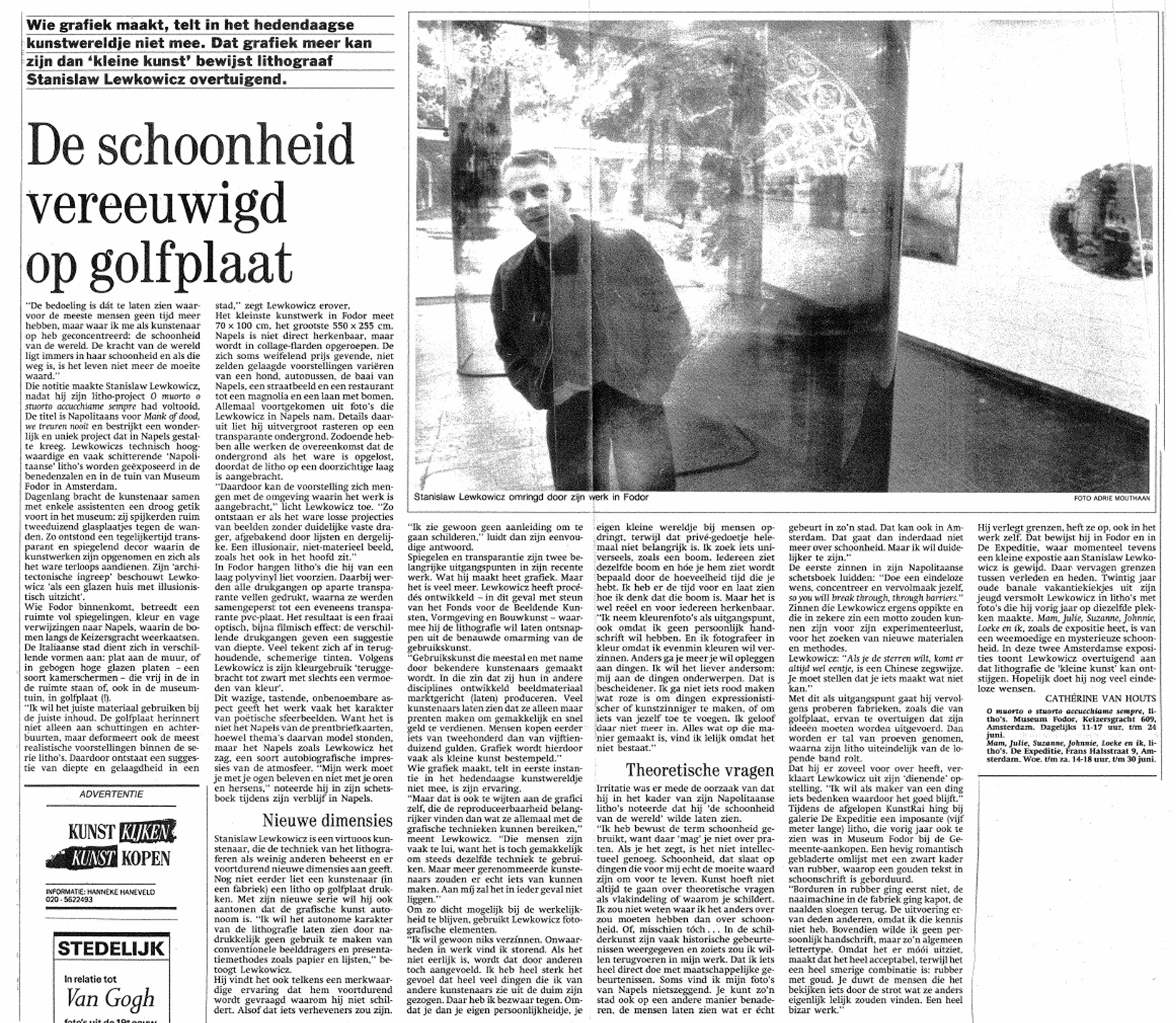
O MUORTO O STUORTO ACCUCCHIAME SEMPE, Het Parool, June 16, 1990
As a continuation of the Grand Tour, ‘Dutchboy Photomemory’ was created out of the ruins of Lebanon, which at that time was destroyed by civil war, and from a journey through Syria and Jordan. The title 'Dutchboy Photomemory' is derived from the name of a paint brand in Lebanon, which could be seen everywhere on large billboards in the then destroyed streets of Beirut. In this series, black-and-white photography is integrated into lithography for the first time. The idea is based on the forgotten practice, but still common in those countries at the time, of colorizing black and white photographs. The last series based on the Grand Tour is 'Disneyland', the name of Israel as it was referred to in neighboring countries.
The extensive experiment in ‘O muorto o stuorto acchiampe sempe’ led to his first major work for public space, an assignment for a striking location at Schiphol Amsterdam Airport; the customs passage in arrival hall 3, a gateway to the Netherlands. This work entitled 'In memory of all those places we do not go because they are not cozy’, is an unparalleled masterpiece in lithographic art.
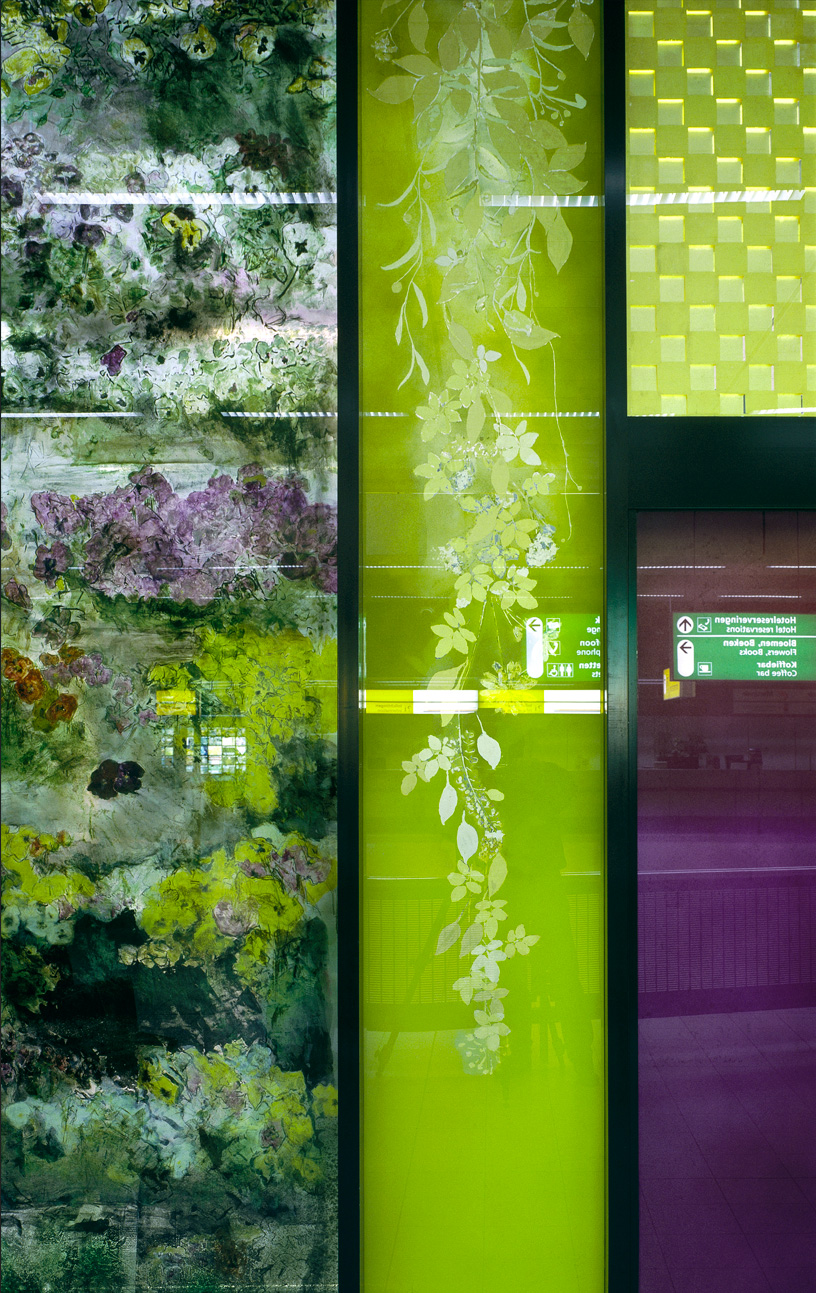
**IN MEMORY OF ALL THOSE PLACES WE DO NOT GO BECAUSE THEY ARE NOT COZY, Schiphol Amsterdam Airport, detail, customs passage, lithography, glass, gold leaf, 4.2 x 34 m, 1995
It is the very first time ever that lithography has been integrated into glass and architecture in this way. Lithographic prints and glass are literally fused into one piece. An application completely conceived and implemented by the artist himself with the kind collaboration of a major glass manufacturer specialized in the production of laminated and double glazing (the same glass as found in every home). In the present day such a collaboration has become unthinkable.
The sudden death of his mother forms the basis for this grand work full of flowers. Flowers for the loved ones as a warm welcome from family and friends waiting at the customs exit, flowers laid on graves and at monuments in memory.
Another experiment in lithography, in the small series 'Acryl & Polyester', led to the artwork 'Pink Cloud', intended for the Public Prosecutor's Office (Bruggebouw) in The Hague, the Netherlands.
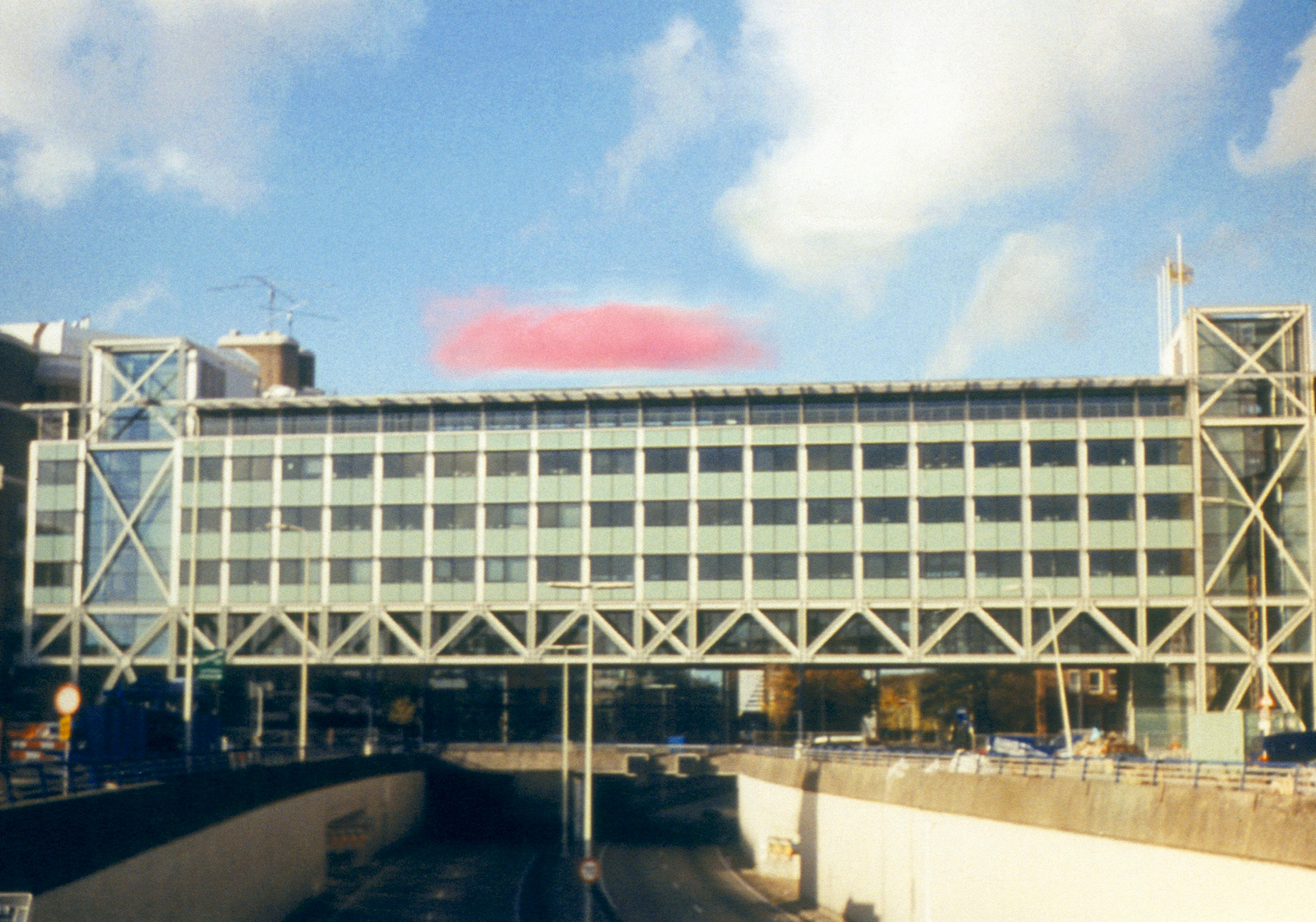
**PINK CLOUD, Public Prosecutor's office (Bruggebouw), The Hague, the Netherlands, water, light, approx. 15 x 3 x 3 m, 1998-2002, not executed
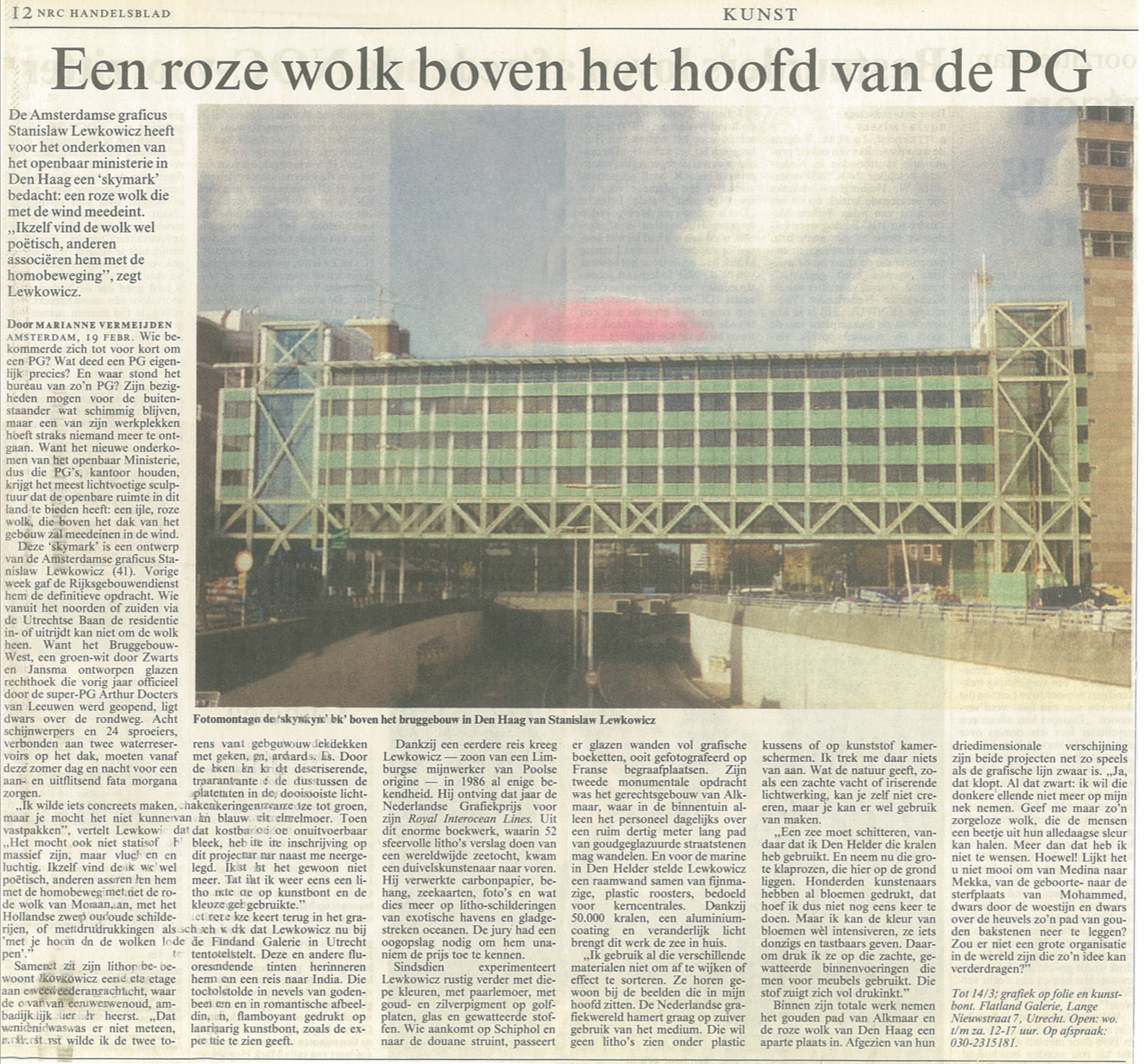
PINK CLOUD, NRC Handelsblad, February 19, 1998
After much research and much resistance from those in power, this work of art was not executed, but it did lead to the work 'Mist Sculpture' for the new building of the Dutch embassy in Berlin, Germany.
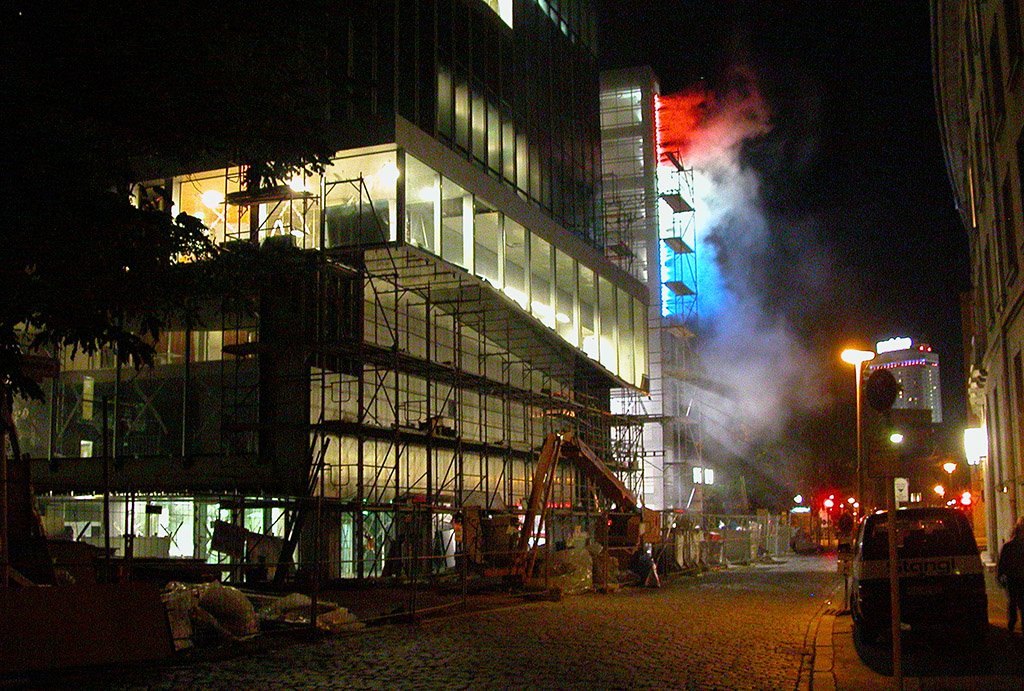
** MIST SCULPTURE, Dutch embassy Berlin, Germany, water, light, 13.5 m x 0.3 m, fog cloud variable, 2004
Then there are series such as the extensive and dark journalistic ‘Carbon Series’, printed on almost black carbon paper, making the white of the printing ink slowly changing into the bright blue colour of daylight as seen in a cave, comparable to the blue colour of the sky. Or the dark series '14 Nothelfer Kapelle’ (‘Chapel of the Fourteen Holy Helpers’), printed on black velvet paper, to emphasize the dark, mysterious aura of these Catholic saints, who are still called upon in times of need.
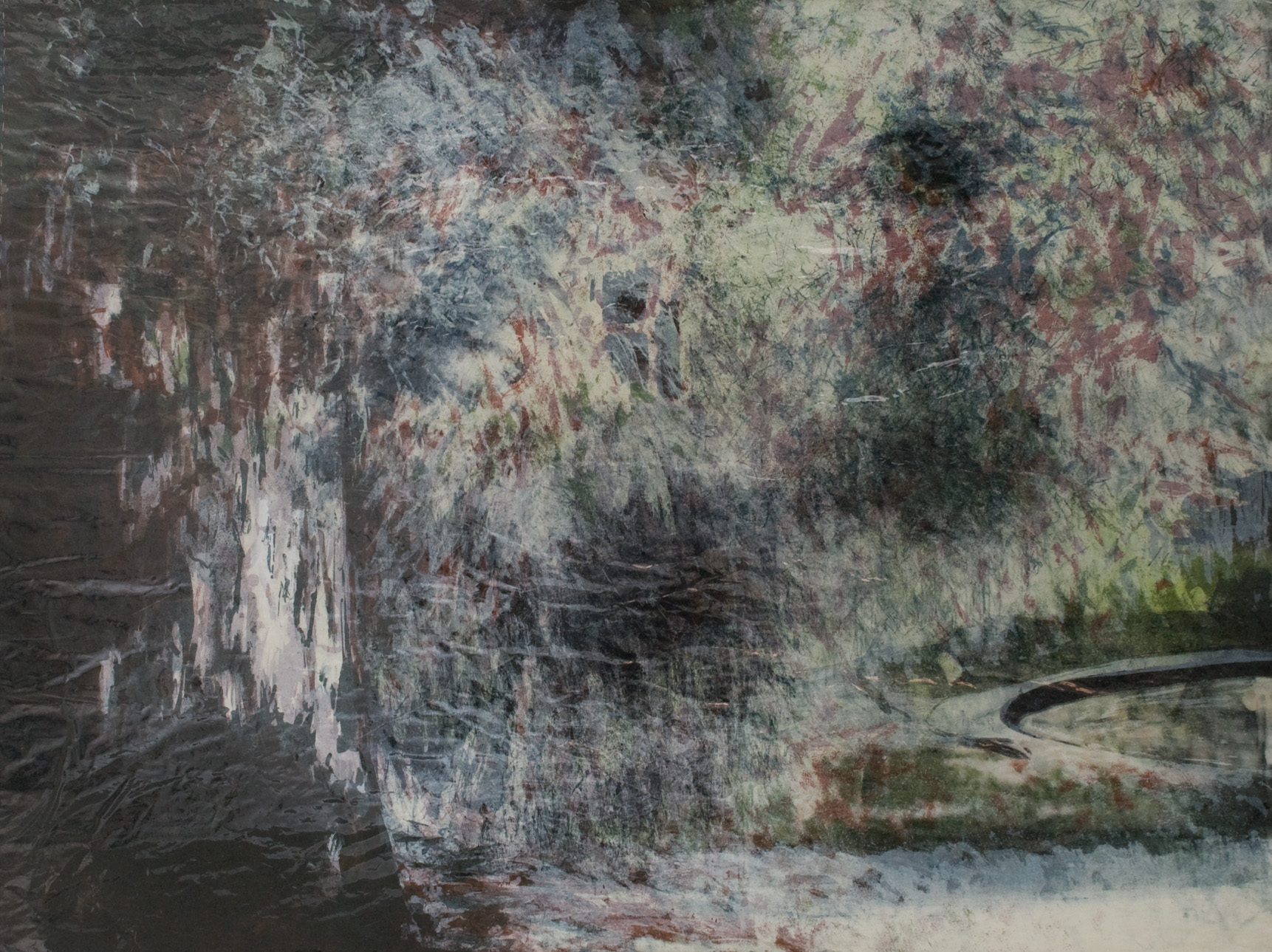
** FOIL, #10, Garden with pond, lithography on wrinkled and layered transparent holographic foil, 104 x 138 cm, edition: 1, 2006-2008
Furthermore, there are the series on a holographic surface such as 'Moonlighting', 'Holiday by the Sea' and 'Walks' in which the image shifts with every viewing angle, just as the image of the world around us shifts with every movement we make and the more cinematic series such as 'Mom, Julie, Suzanne, Johnie, Loeke and I', 'Foil', 'Les Baigneurs', 'National Highway N278', 'Fragmentary Memories', '14 Days of Holiday'. In these series the different layers of color are placed on top of each other as separate, transparent layers to capture movement and the passing of time.
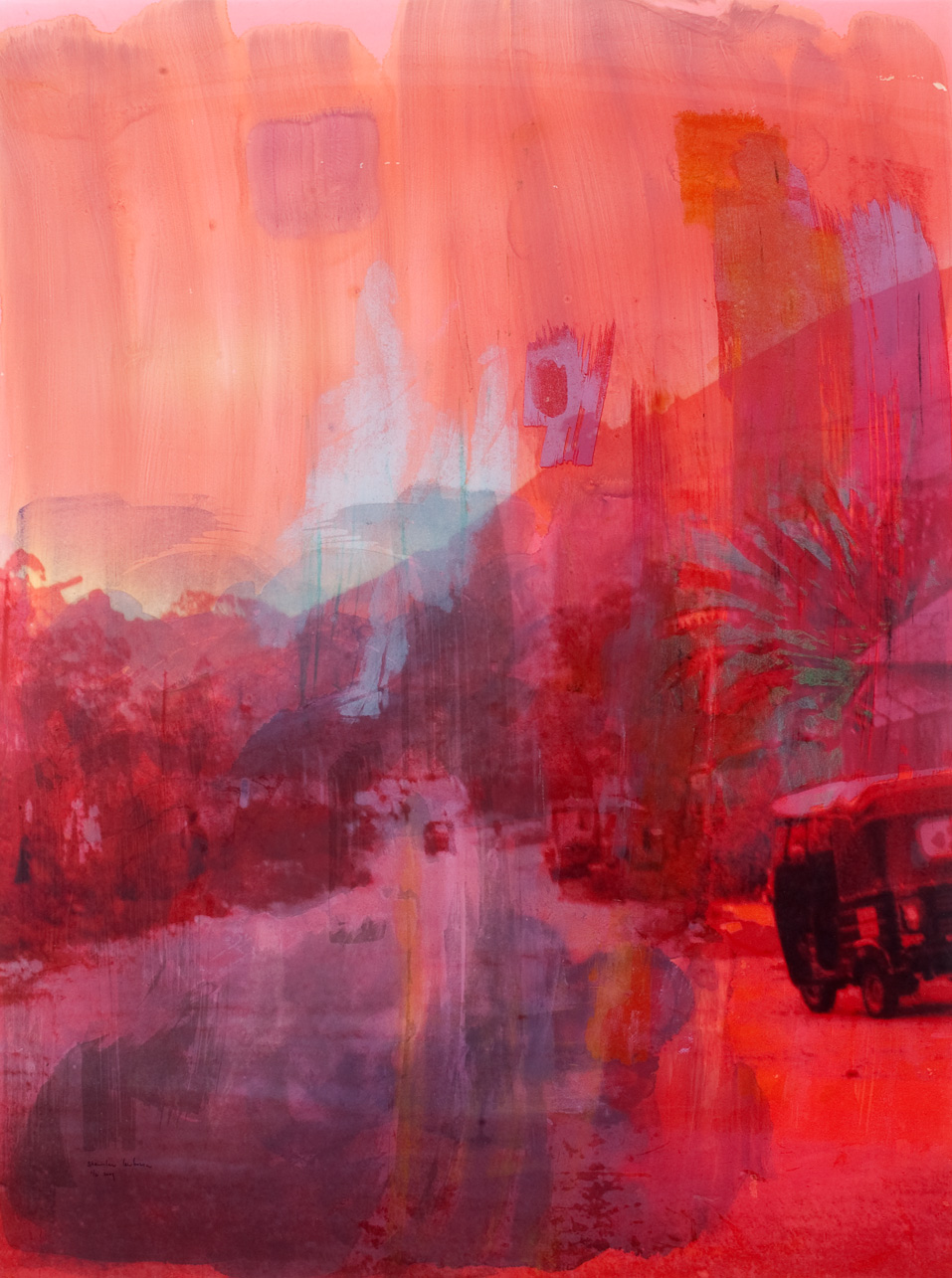
** I Won't Let You Go, #11, lithography, layered, epoxy on dibond, 82 x 110 cm, edition: 3, 2009
The series 'I Won't Let You Go’ echo’s the death of his companion in life. Years later, the never-ending feeling of loss is reflected in the work 'Greetings from Calcutta’.
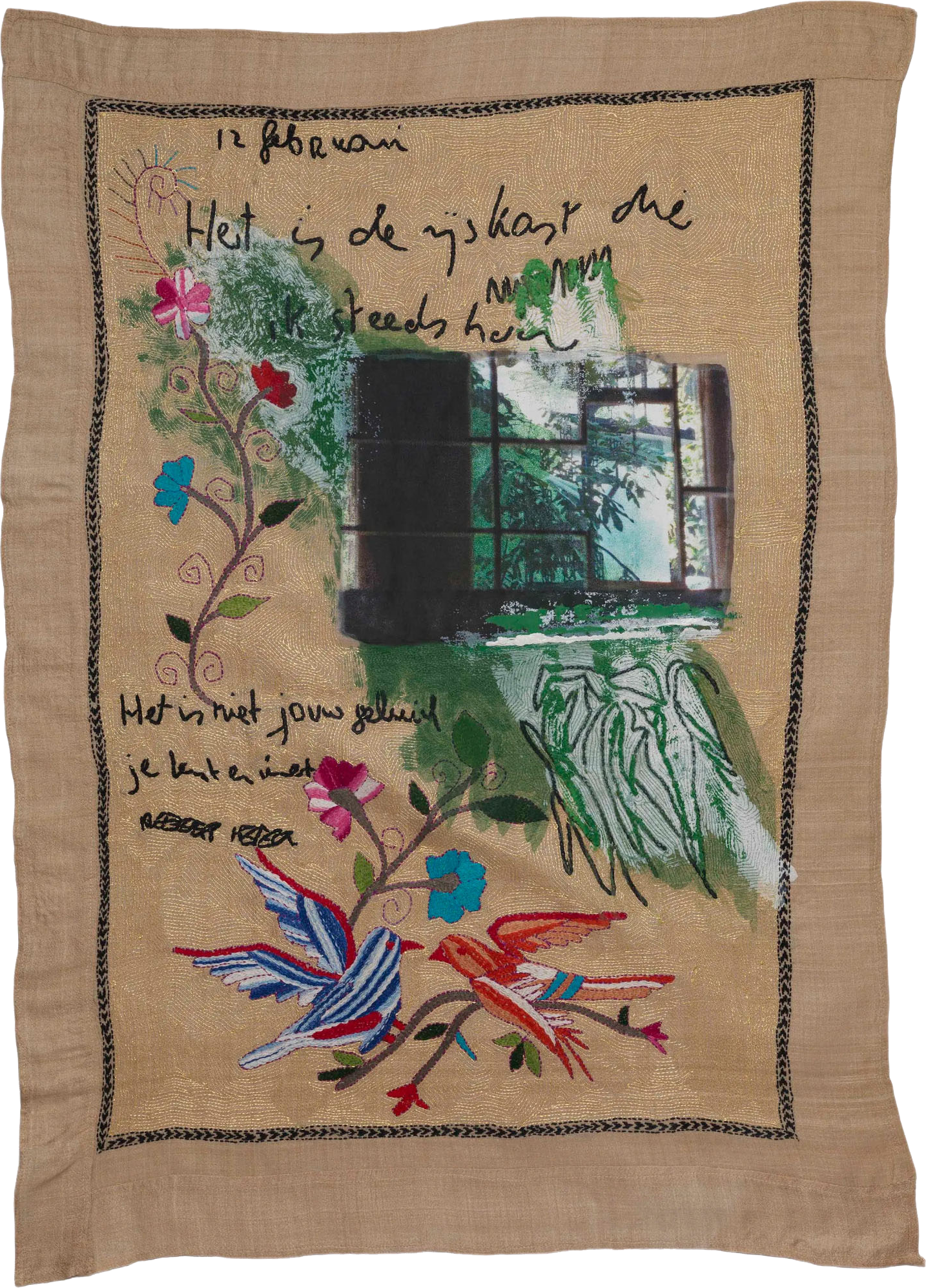
** GREETINGS FROM CALCUTTA (detail, February 12), 27 parts of different sizes, approx. 240 x 530 cm, lithography and digital printing with Kantha stitching on Tussar silk, in handmade box, edition: 1, 2017
Titles such as 'One, Two, Three, in God's Name', 'Return Return, Oh God Return', 'Big Bang', 'Time Flows in Silence', 'I am a God in My Deepest Thoughts' suggest that there is a perhaps unconscious religious motivation.
Later work deals with the state of the world, such as the series 'Dhoti Poems', conceived in a hotel room in the overheated and crowded centre of Calcutta in West Bengal. This series is about the difficulty of human contact, as does the lonely series 'Poems' in which the too long days are scratched on wallpaper.
The series 'Teerth', 'Fading World', 'Alter Ego' and 'O.M.G.' reflect our current world as a contradictory world in transition, but a world in which the living being constantly repeats itself and in essence nothing really changes.
The apocalyptic reality
Now that he has reached the last part of his life, Stanislaw Lewkowicz no longer uses lithography as a medium in his work. His litho press moved from Amsterdam in the Netherlands to Athens in Greece to assist a young artist in her attempts to revive lithography, free from the interference of master printers and stifling graphic studios.
He has returned to the beginning of his adult life, how it all started as a globetrotter and vagabond. Rather than his studio in Amsterdam, the planet itself is now the cradle of his art. In recent years, this has mainly been the extensive subcontinent of India. The subcontinent where all the worlds of this planet come together. Due to lack of money forced to escape the bubble of the western world. Staying in budget hotels, traveling around with local buses. Always close to reality as it appears to most people. In the reality of life that most people have to deal with. But as a traveler, the observer. What he sees is an all-consuming emptiness that is hard to deal with. Surrender seems to be the only answer.
Along the way he merges into what he encounters, not only in beauty and ugliness but also in impressions, neutral, almost emotionless, observing. Waking up just before sunrise from the distant call to prayer as an eternal reminder that there might be more somewhere beyond the light of the rising sun, in the immense black beyond. From the sound of running water in the early morning hours on the stainless steel kitchenware of the downstairs neighbors. From their child's call. From the sound of the voice that answers. The same answer every time.
This merging with the surroundings is already visible in his early masterpiece ‘His Thoughts Swam Away in the Waters of the Ourthe. The Body Remained on the Stones. Only for a Moment. Then it was Over’.

**HIS THOUGHTS SWAM AWAY IN THE WATERS OF THE OURTHE. THE BODY REMAINED ON THE STONES. ONLY FOR A MOMENT. THEN IT WAS OVER, lithography, projection on offset plate, printed on pvc, pasted on rubber, gold embroidered text, 70 x 565 cm, edition: 5, 1988
Nowadays he sometimes sits somewhere thinking: 'If I were to die on the spot, I should be happy. Instead, I fear dying in public. All the commotion it will cause. What a disgrace.’ But what could be more beautiful than simply die in a bus, somewhere along the way in Srinagar, in the orange-pink glow of the setting sun at the end of the road? Right there, what could be more beautiful? To die on the banks of the Ganges, alone, sitting on a bench, amidst the hustle and bustle around it. What could be better than to merge with the warmth of the past day? To let the body go up in smoke. Smoke that mixes with the air, air breathed in by plants, animals and people and thus brought back to life. No romance here. It is just ever-repeating apocalyptic reality.